In this article, you’ll discover 3 SaaS SEO strategies for boosting organic traffic and increasing your SaaS conversion rate.
We’ve used these 3 strategies to grow our SaaS business, and the graphs below show the positive trend.

Our guide is made to be very practical and actionable:
- We share our own experiences.
- We provide concrete examples.
Let’s get started and bring your SaaS SEO to the next level.
Table of Contents
What is SaaS SEO and Why is it Important?
We assume you have a basic understanding of SEO.
You know that SEO is crucial for improving your visibility on search engines.
Your company must develop an SEO copywriting strategy and create content that ranks well so your target audience can find you and become customers.
SaaS SEO will help you to:
- Get more traffic
- Attract new users
- Showcase your expertise
- Increase conversion rates
- And… Reduce your spending on paid campaigns.
Building a solid SEO and content foundation is an asset that will grow in value over time.
We understand that SEO is challenging, especially in the B2B SaaS space where thousands of pieces of content have already been created.
This is why we would like to share 3 SEO strategies for your SaaS that are proven to work.
SaaS SEO Strategy 1: Creating Free Tools
Creating free tools is an excellent SEO strategy for your SaaS.
At thruuu, we initiated a “Free Tools Strategy” in April 2023, and you can see that it has significantly boosted our visibility on Google Search.
Developing free SEO tools for content writing helps us attract more traffic and increases our conversion rates.
Indeed, when users try the free tool, they will likely sign up for a trial and eventually purchase a subscription.

What Do We Mean by a “Free Tools” Strategy?
Maybe we should clarify what a “Free Tools” SEO Strategy means.
A Free Tools Strategy leverages free tools on the SaaS website to drive traffic and conversions.
The tools must be free and accessible without requiring a login or an email address.
This is crucial: do not create friction in the user journey, and offer the tools without asking for data in exchange. You will bring the user back to your SaaS in a different way.
You can visit our free tools page and check out the Website Comparison Tool.
This free tool compares two URLs and their on-page data. It is an excellent solution for optimizing your page against a competitor.
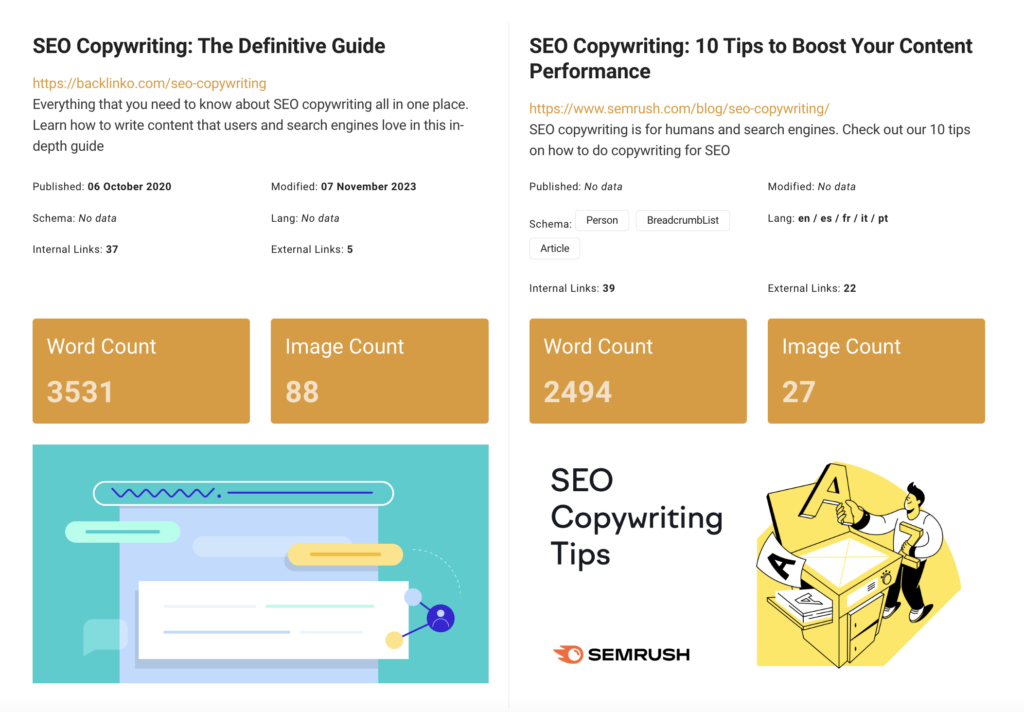
As you can see, the tool is frictionless. We don’t ask for an email.
Additionally, this tool offers a lot of value to our target audience. Another element to consider is that your free tool must be helpful.
Let’s discuss how to implement this SEO strategy effectively.
How to Effectively Implement a “Free Tools” SEO Strategy
A free tools strategy is linked to a product-led growth approach and must offer a solution to your audience’s pain point.
You offer either a feature of your SaaS or build a free feature related to one of your core features.
At thruuu, we have developed several free tools, such as the Keyword Frequency Checker and the Website Text Extractor.
These small tools address the specific needs of SEO experts looking to analyze frequent keywords on a page or extract page content for other manipulations.
These small tools highlight features that are available in one of the core features of thruuu.
Indeed, one of the thruuu core features is a SERP analyzer, which goes beyond analyzing a single URL.
With the thruuu SERP Analysis tool, you can analyze any Google SERP, with 100 URLs per analysis, and offer advanced reports that combine on-page data, transformation and analysis based on AI.
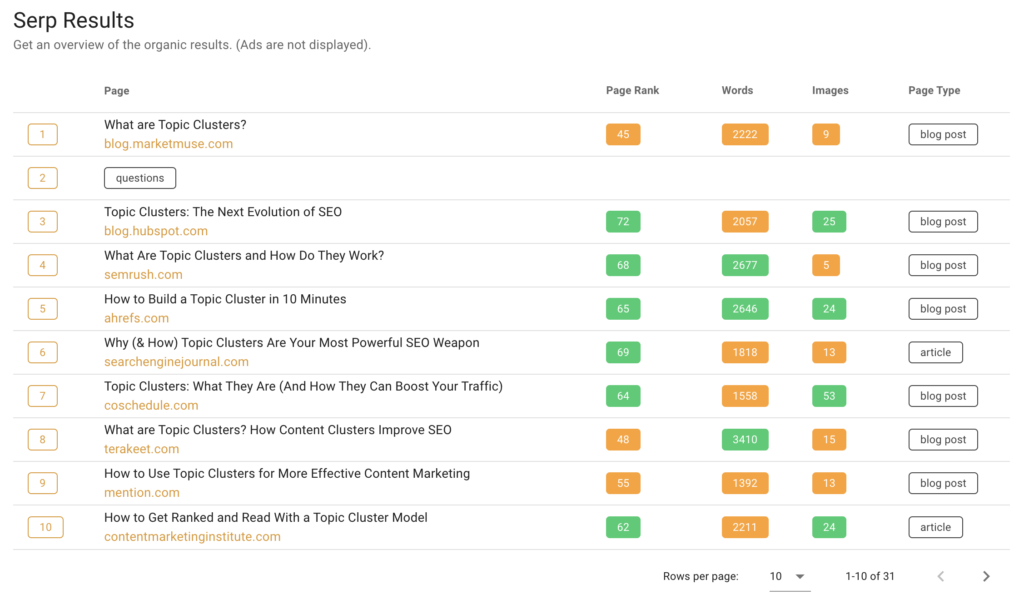
This is the point of these free tools: offering a taste of your product and showing the benefits of signing up for a trial.
Implementing a remarkable landing page is essential to the free tools strategy.
The landing page must feature the free tool as a central element, and below, you can highlight the benefits of your SaaS and invite the user to sign up for the trial.
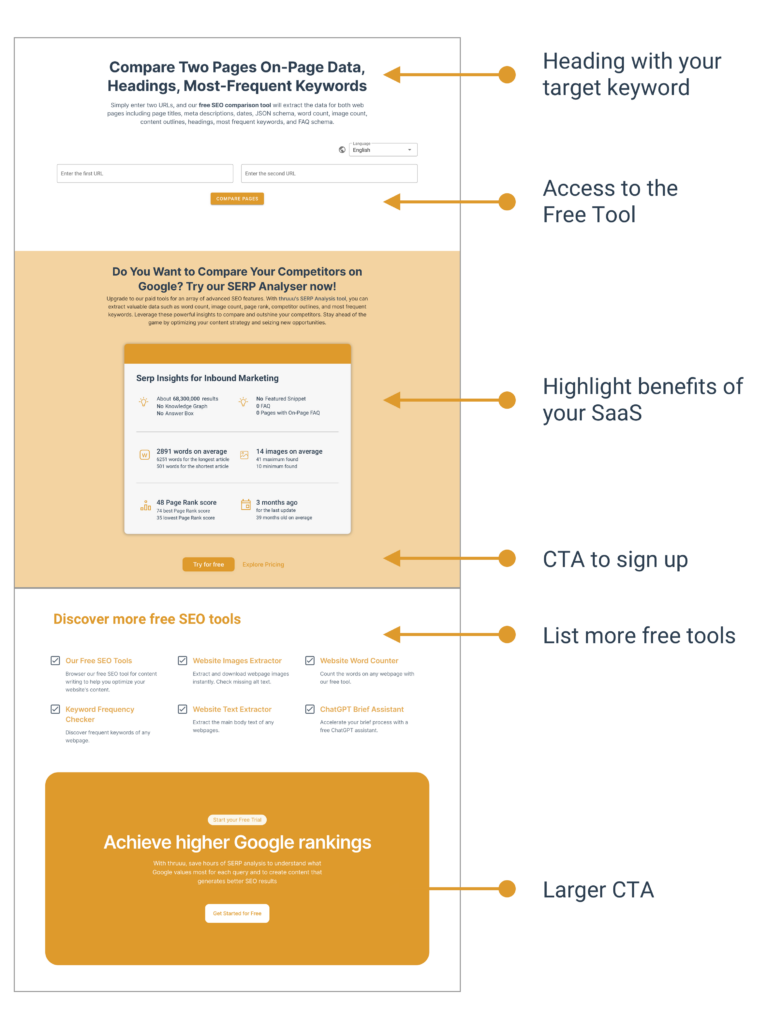
Building a remarkable landing page is critical in optimizing conversion rates.
There are other strategies to improve the conversion rate.
When the free tool is loading, you can display a popup to invite the user to sign up, or you can also display half of the result and blur the second half, inviting the user to sign up to get more data.
You can see that Ahrefs is also using this approach. We need to sign up to check all our backlinks when using their free backlink checker.
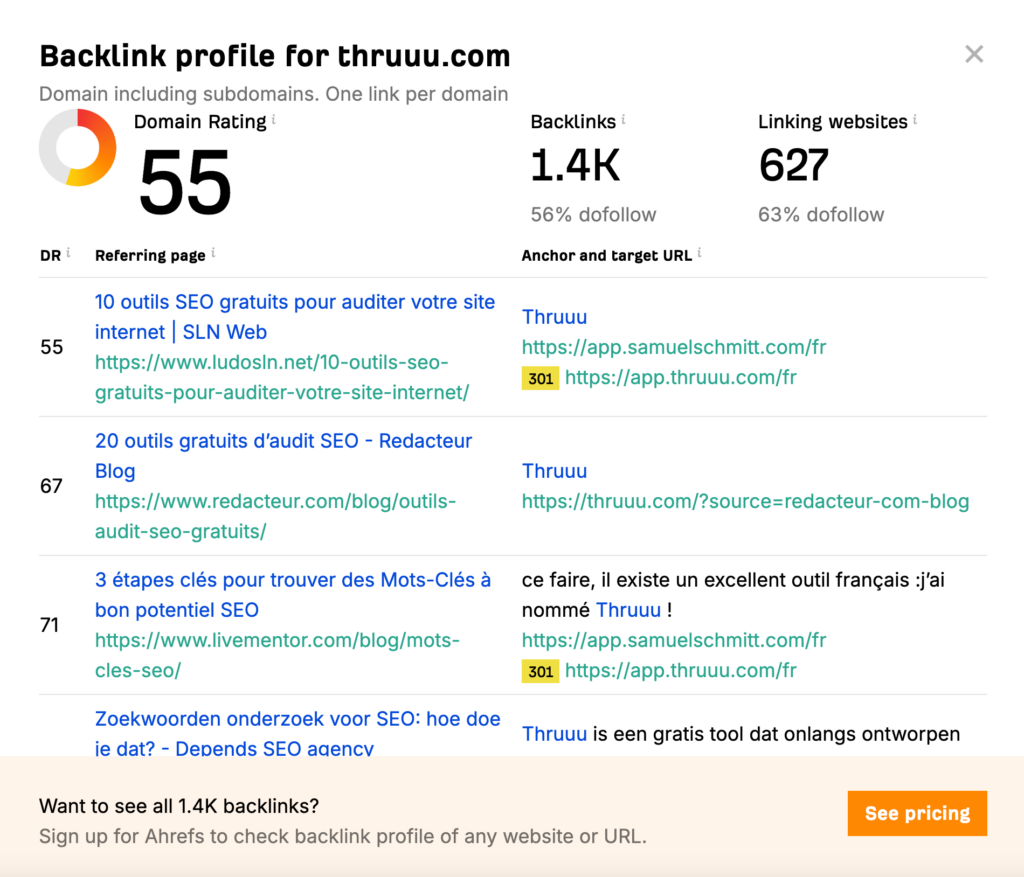
How to Get Great Ideas for Free Tools for Your SaaS?
As we mentioned earlier, your free tools support your product-led growth strategy.
The free tools showcase one aspect of your offering and drive customer acquisition.
One way to generate ideas for free tools is to collaborate with your product team. Explain the principle that offering something for free could lead to more customers. They will likely find ways to expose some functionalities to your audience.
But will these free functionalities interest your audience?
Let’s take a data-driven approach.
You can use Google Search Console to get content ideas, so why not use it to get ideas for tools?
Your website might already rank for “free tools” related terms. Here’s what you could do:
- Open Google Search Console.
- Go to Search Results.
- Create a Query Filter.
- Enter a custom regex like the following one
💡 Customer Regex to Get Tools Ideas
tools|tool|free tool|free tools|generator|calculator|checker
PS: Adapt this regex based on the type of tools you offer and the typology of your user searches.
As you can see, Google Search Console is a gold mine. You can quickly identify ideas for new tools.
In our case, we got a great idea with a webpage word count checker.
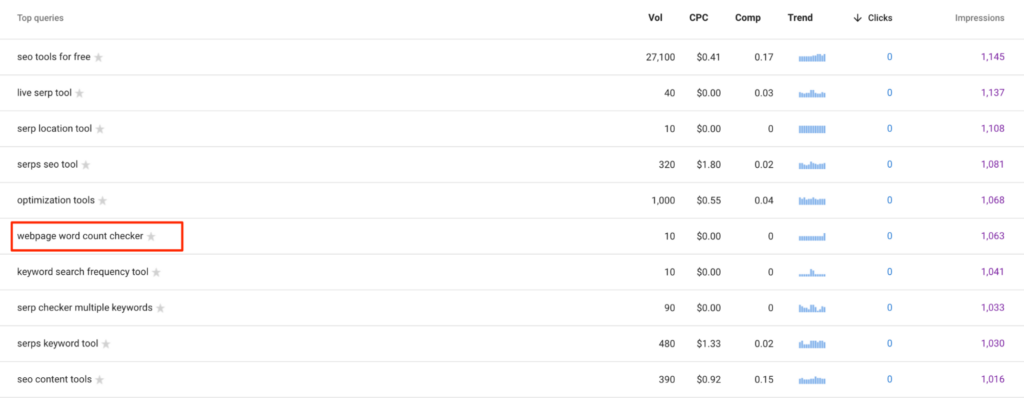
If you already have a list of free tools on your website and are looking for more ideas, you can also apply this filter:
- Open Google Search Console.
- Go to Search Results.
- Create a Page Filter.
- Enter the URL of the page listing all your tools.

Do you want to take it a step further and extract the main ideas to focus on from your long list of keywords?
Once you’ve exported keywords from GSC, you can use the thruuu Keyword Clustering tool.
Our tool groups keywords that show the same SERP together, helping you focus on topics rather than individual keywords.
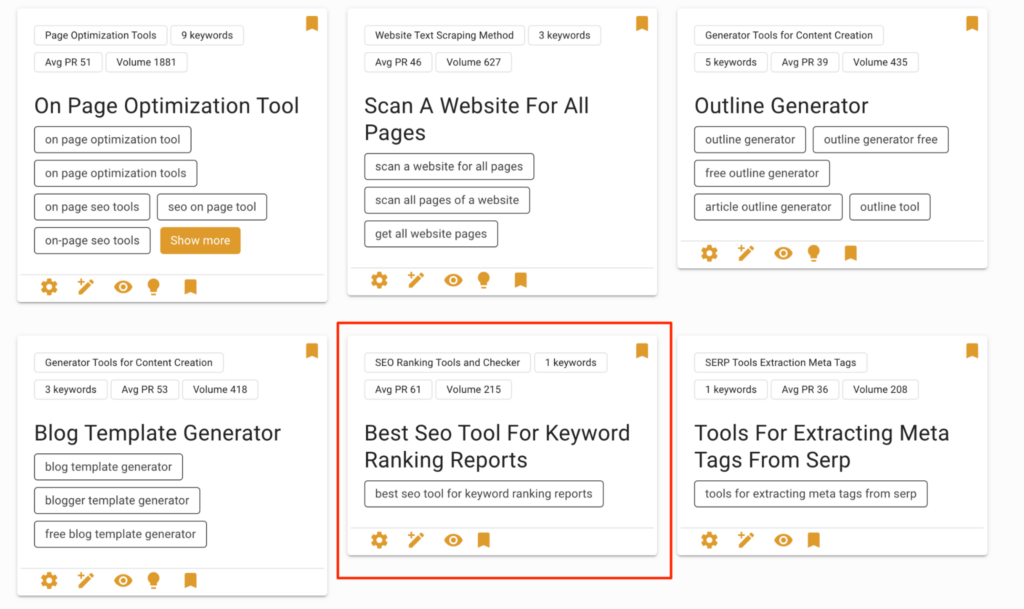
With the keyword clusters identified, you can pinpoint topics where a free tool is an optimal solution and others where a listicle or product review may be more appropriate.
Using thruuu, you can analyze each cluster’s top articles and competitors to guide your strategy. This analysis helps you understand what type of content is needed—whether it’s a free tool or an article.
If you look at the image above, five topics could be answered by creating a tool, while one topic could be addressed with an article.
As you can see below, the cluster content analysis for “Best SEO Tool for Keyword Ranking” reveals that the top articles ranking for this cluster predominantly review tools.

This insight indicates us to curate content that aligns with these findings and write a product review.
Before speaking about the next strategy, we can conclude with the ROI of this approach.
ROI and Benefits of the Free Tools SEO Strategy
At thruuu, we believe this is the best approach because it:
- Drives traffic
- Creates conversions
- And it is not that expensive.
As a SaaS, you likely already have a team of developers working on your main product.
At thruuu, it took us about one or two days to build a single tool. You can do the math based on the cost of your developers.
We built six tools. They have generated millions of impressions (good for branding), thousands of clicks, and hundreds of sign-ups (good for revenue).
This strategy outperforms content production and is only slightly more expensive than producing long-form articles that might never rank in the top 10.
Another benefit of this strategy is its potential for link building.
People like to share new tools, especially when they are free.
You will increase your chances of being mentioned in product reviews and gaining a backlink.
SaaS SEO Strategy 2: Focus on BOFU Content
Content marketing can be summarized into three stages:
- TOFU (Top of Funnel) Content
- MOFU (Middle of Funnel) Content
- BOFU (Bottom of Funnel) Content
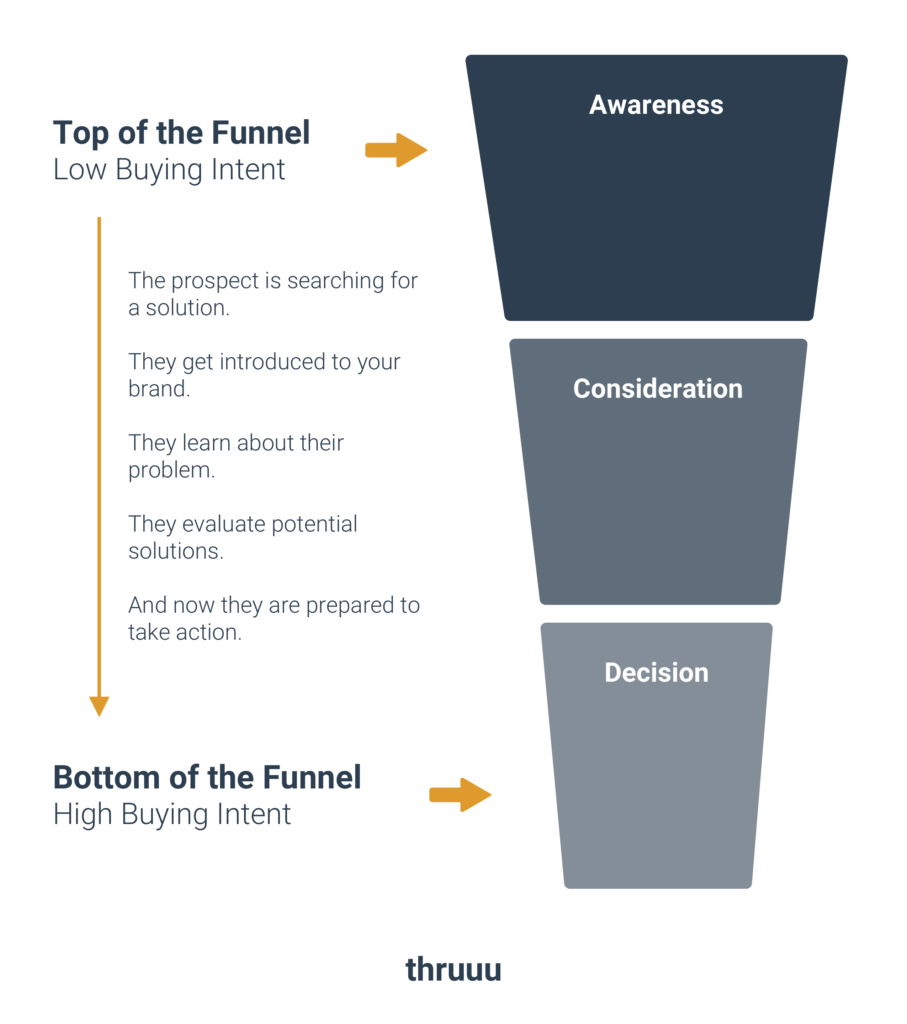
When your audience reaches the bottom of the funnel, their buying intent is high. They have completed their research and are ready to sign up for a trial of your tool.
You could create specific types of content for bottom-of-the-funnel searches.
These types include
- Related Product Review
- Competitor Review
- Competitor Alternative
- Versus
Interestingly, the Free Tools highlighted in the first strategy also fall into this category.
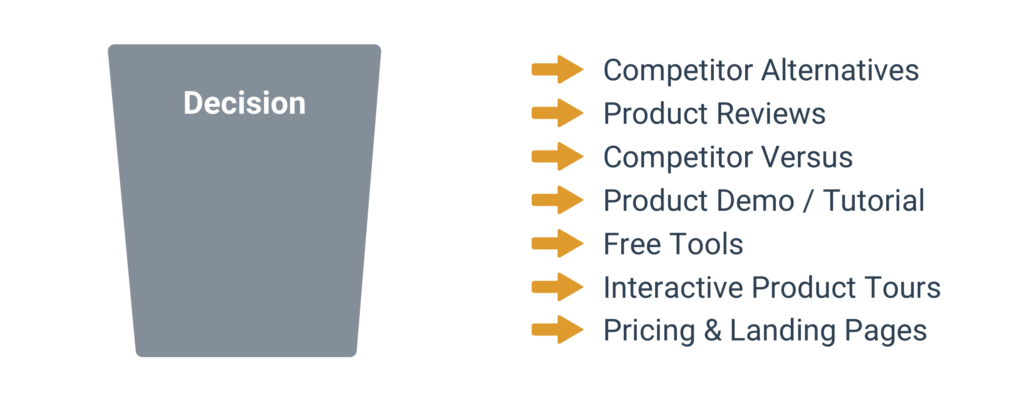
At thruuu, we have successfully employed this strategy and would like to share some examples of BOFU content.
Related Product Review
Related products are not direct competitors but are tools that could interest your target audience. These tools could be used together with your solution, as a complement.
At thruuu, we offer solutions for SEO Strategists, Content Managers, and Copywriters. We aim to help content teams create better content.
Our target audience might be interested in free content writing tools, so we have created a list of the top 10 essential writing tools.
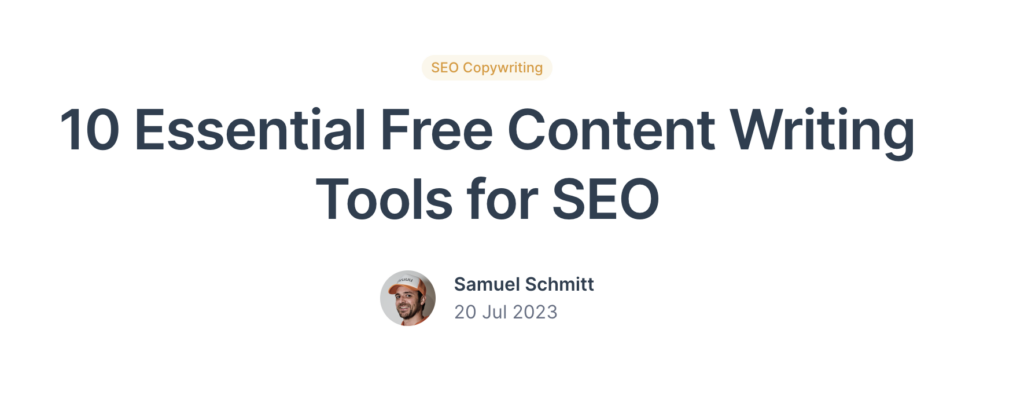
As you can notice, this piece of content is performing exceptionally well. It has started to climb the SERP even though the article was published less than six months ago.
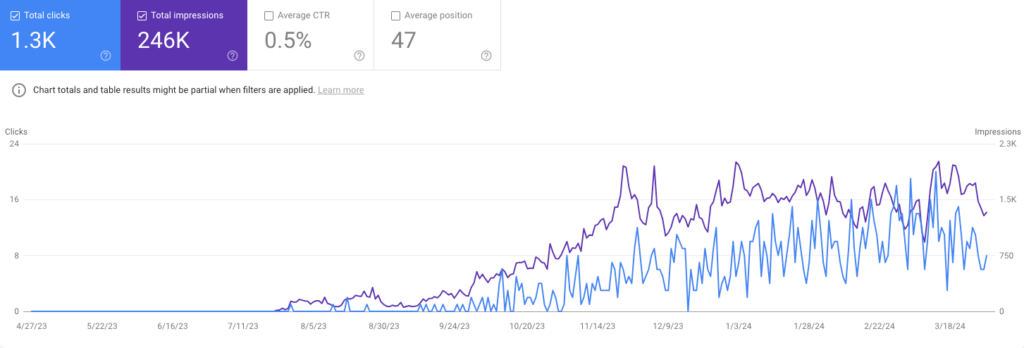
Beyond generating traffic, this article also drives sign-ups.
Indeed, people searching for content writing tools might be interested in our solution.
We strategically place CTAs within the content and mention our free tools to invite the reader to try and sign up.
Empower Your SaaS Content Team
Our end-to-end content optimization solution empowers your team to crack the Google algorithm, craft exceptional content, and achieve remarkable organic search results.
We can share another example of a related product review with our selection of content optimization tools.
The article listing 13 free content optimization tools follows a similar trend.
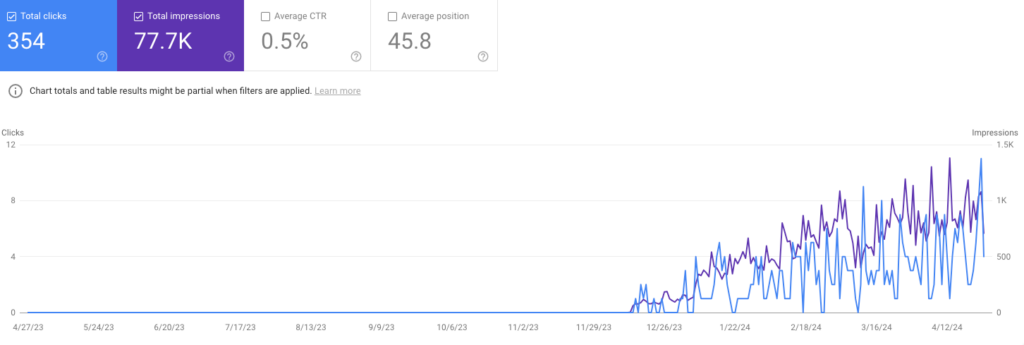
This approach not only drives sign-ups but also boosts our visibility significantly.
Over a period of time, 128 users landed on the page, resulting in 8 sign-ups for a trial. This represents a conversion rate of about 6%

A key aspect of our strategy is our focus on free tools (yes, again).
However, this time, we specifically listed these free tools in our review.
This strategy has helped us rank in the top 3 on Google for a competitive term like “content optimization tools.”
While many reviews cover the “Best” tools, we decided to bring a new angle by focusing on “free” tools.
This winning approach addresses a search intent that still needed to be met: people looking for free content optimization tools.
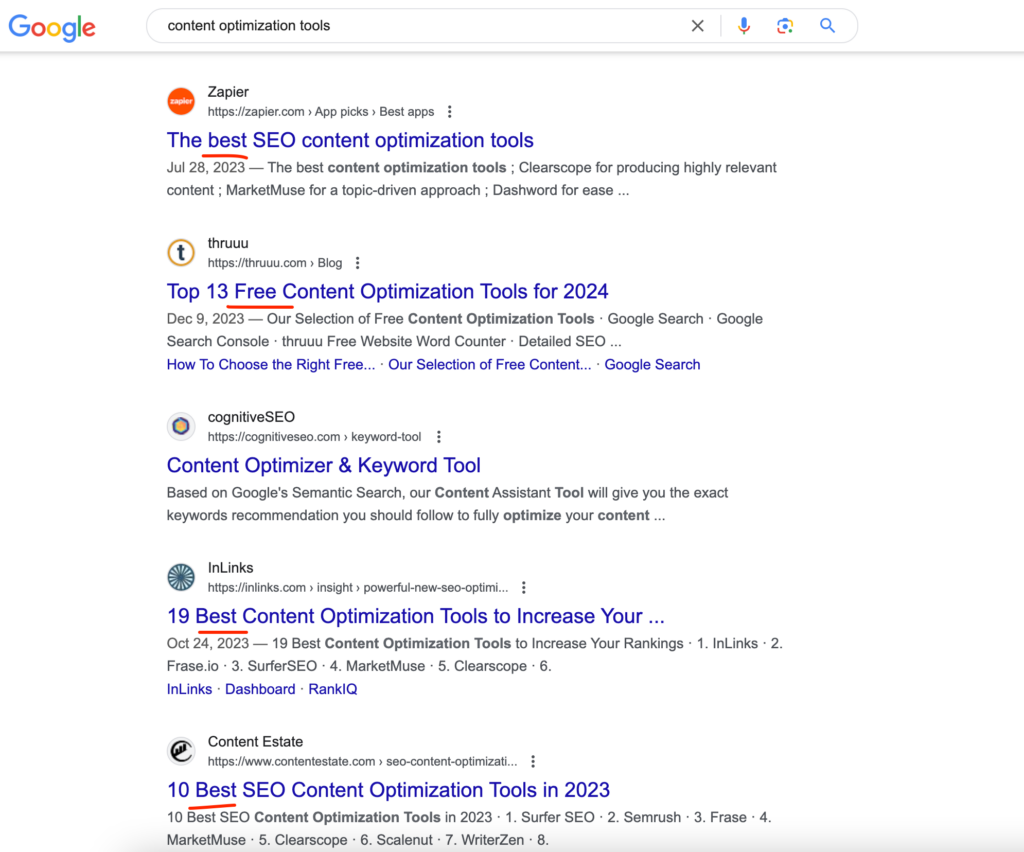
We rank also for the exact search about “free content optimization tool“. But this time at the first position.
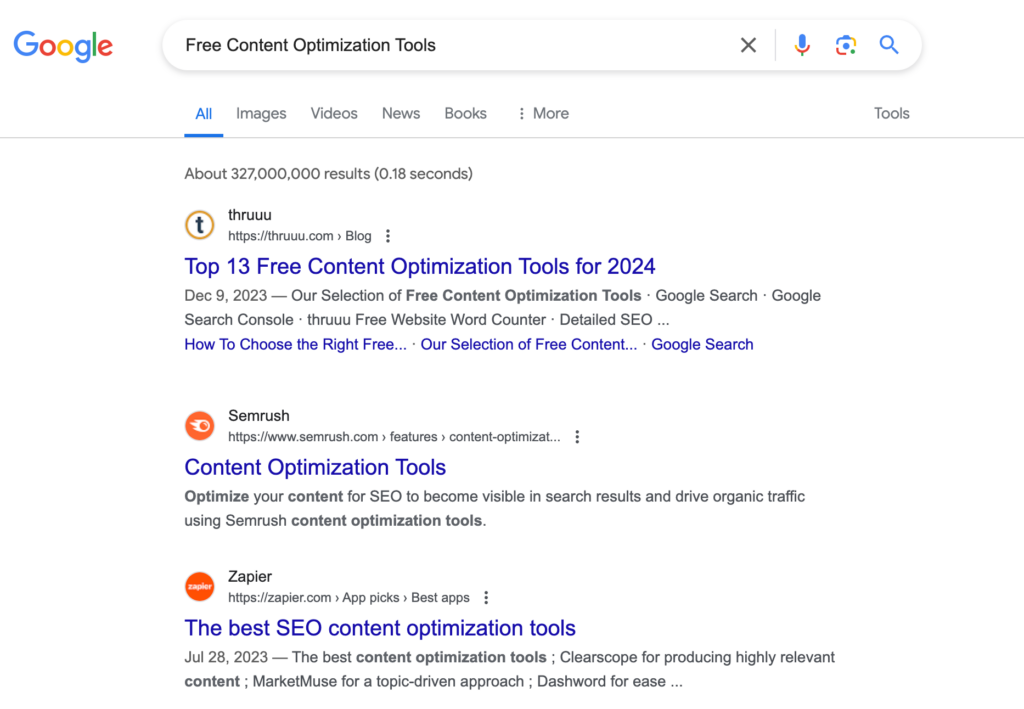
We recommend creating related product reviews and focusing on free tools if available in your niche.
Another advantage of such tool listicles is that they are easy to create.
A listicle is a straightforward article format, and a professional copywriter could do some research to produce a good review.
To continue with BOFU content, you can also leverage other types, such as:
- Competitor Review
- Competitor Alternative
- Versus
And here are some examples to inspire you.
Competitor Review
A competitor review is quite similar to a related product review, but as the name suggests, you are reviewing direct competitors here.
We advise including your best competitors in this list and providing honest reviews.
Don’t try to deceive your audience by criticizing your competitors.
Instead, highlight your value proposition and demonstrate why it makes sense to try your product compared to another.
At thruuu, we have also employed this approach with excellent results.
We have published two reviews to promote our keyword clustering tool.
As you can see, these two reviews rank on the first page of Google.

Yes, you read that right. Two reviews rank in the top 10.
Maybe it’s worth a little explanation!
The first review is about the best keyword clustering tools. Here, we list thruuu keyword clustering tool and its main competitors.
This is why we rank high in the SERP, as it effectively addresses the search intent of someone looking for the best keyword clustering tools.
A bit further down the page, you can find another article from our blog listing free keyword grouping tools.
In this review, we don’t list thruuu, only the free keyword grouping tools available on the market.
This strategy helps us secure two spots as we answer two related search intents:
- People looking for the best keyword clustering tool
- People looking for free keyword clustering tools
By following this strategy (Best vs. Free), you can double the number of reviews on your website and maybe secure two spots on Google first page.
Competitor Alternative and Versus
Competitor alternatives and comparisons are also great content formats to drive growth.
For instance, let’s say we compete against SEMRush (not yet).
If this becomes the case, we could have a page titled “SEMRush Alternative” on our blog, listing the top alternatives, including thruuu.
Competitor alternative is a listicle format listing competitors.
As you can see below, Google suggests the modifier “free“.
This presents another opportunity to list one of your competitors’ free alternatives and drive traffic to your website.
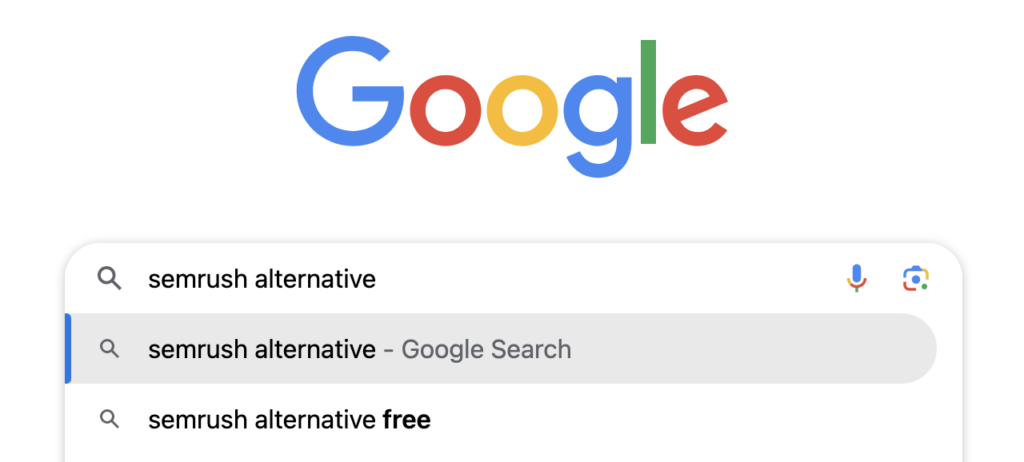
Comparison or Versus format entails directly comparing two SaaS products.
This often involves comparing your product against one of your main competitors.
For example, Pipedrive compares itself against Salesforce.

You can expand this format to include three SaaS: yourself versus two other competitors.
As demonstrated by Ahrefs, they employ this approach effectively and can rank for two comparisons in one article:
- Ahrefs vs SEMRush
- Ahrefs vs MOZ

Another variation is using the versus format to compare two competitors while mentioning your solution as an alternative at the bottom of the review.
An example of this can be seen in the comparison between HubSpot and Mailchimp by Customer.io.

After explaining the main differences between the two solutions, Customer.io introduces its solution as an alternative.
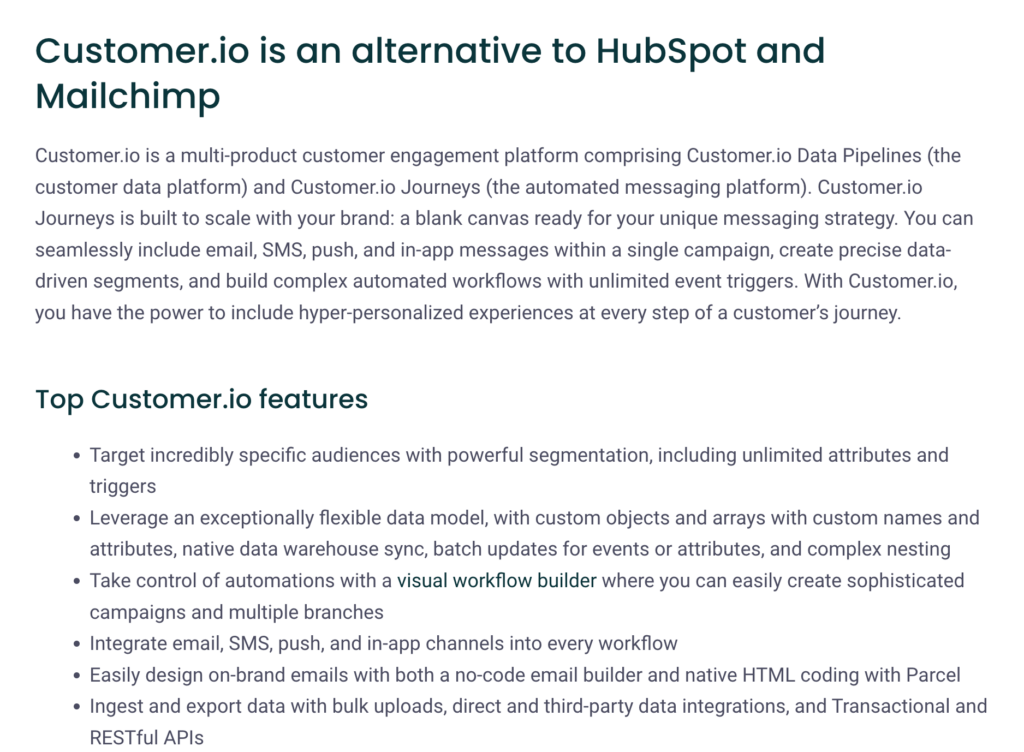
These examples of BOFU content will assist you in driving traffic and conversions to your SaaS.
Now, let’s review our final SEO strategy.
SaaS SEO Strategy 3: Topic Clusters
Our final strategy revolves around developing a topic cluster content strategy.
We’re particularly fond of this approach not only because our tool offers a feature that helps accelerate the creation of topic clusters but also because we use it for our content strategy.
As you can see below, we launched a topic cluster in November 2023, showing remarkable results.

The funny thing is that we created a topic cluster about topic clusters…
Yes, really!
You can visit the pillar page about a topic cluster content strategy here.
This is the main page of our topic cluster, which lists articles about topic clusters.
We start with educational content explaining:
Then, we share a
- guide to help you create your first topic cluster
- and some examples of topic clusters.
Finally, we will highlight our tool and explain how thruuu can help you create topic clusters.
If you don’t know yet what a topic cluster is, you should get the idea now.
Creating articles around a main topic
Topic Cluster is an SEO content strategy that involves creating a series of content about a main topic.
Each article answers a sub-topic of your main topic.
These so-called cluster pages are linked together by a main page called the pillar page.
If you want to learn more, you can visit our website, where you’ll find enough resources on the topic.
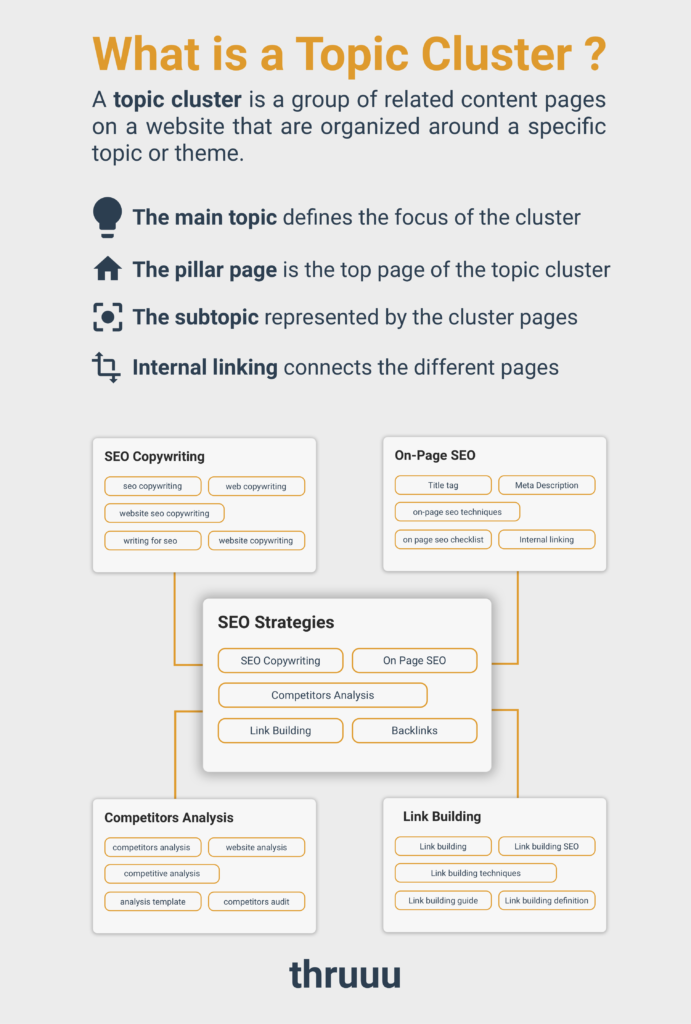
Topic Clusters for SaaS
Also, we have published a specific guide explaining how to create a Topic Cluster for a B2B SaaS.
Indeed, there are some particularities to understand for SaaS that we can develop now.
Ultimately, your goal is to get sign-ups and paid users. You want to be seen as a solution to help your target audience.
Developing a topic cluster in the context of a SaaS can help you reach your goal.
First, your topic cluster should highlight how you can solve customer issues with one of your core features.
Based on the customer journey stage, you should highlight your solution more or less.
In other words, the further down the content funnel you go, the more you can highlight your product features.
With a topic cluster, you can develop customer-centric content and be visible along their journey.
A well-executed topic cluster strategy will produce content from the top to the bottom of the content funnel.
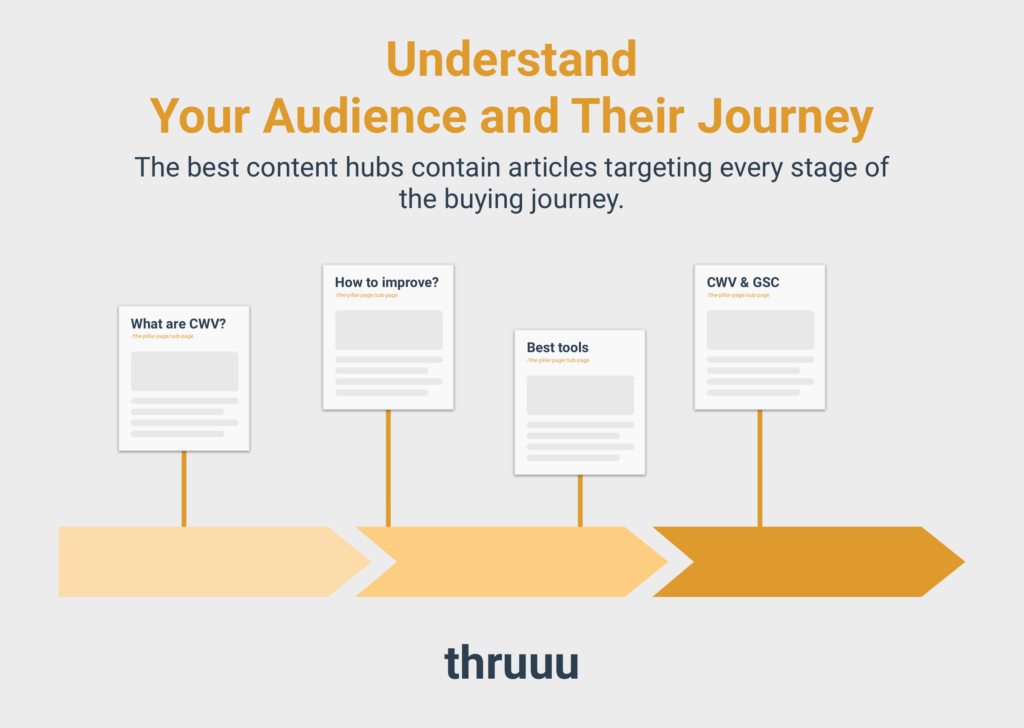
Ultimately, your goal is to reach what we call topical authority.
Your brand must be seen as a trusted source of expertise, and as users search and learn more about their problems and find potential solutions, they will see your brand.
Visibility at every stage of the customer journey is essential; topic clusters can help you achieve this.
In the video below, we share a technique for generating thousands of content ideas using PAA (People Also Asked) and related searches.
Fresh data from Google can help you build a great content plan for your SaaS.
One remark: We mentioned focusing on BOFU content previously.
This can also be done by following a topic cluster strategy.
When you define the set of articles you want to produce, you can start by creating the BOFU content and then move up to the TOFU content.
Bonus: Insights from 300 B2B SaaS Websites
We had the chance to host a webinar with Tom Shapiro, CEO at Stratabeat, where he shared the key findings from a deep analysis of 300 high-performing B2B SaaS websites.
Here are the most important takeaways to shape your SaaS SEO strategy in 2025:
Google Still Dominates
Despite the rise of AI tools, Google remains the go-to search platform, generating 373x more traffic than AI-based search engines.
SEO is not dead. Far from it.
AI Overviews Are Limited (But Real)
AI Overviews mostly appear on TOFU queries (e.g., definitions). You can still win these queries or focus where AI Overviews don’t show up yet.
Top Performers Combine Many Tactics
Successful B2B SaaS sites use a mix of strategies:
- Blogging frequently (11x/month)
- Publishing original research
- Using strong internal linking
- Creating custom visuals
- Segmenting their audience precisely
There’s no silver bullet. It’s the combination that works.
Backlinks Matter Less
Top performers grew traffic with fewer backlinks. Backlinks aren’t gone, but they’re no longer the primary growth driver.
Longer, Deeper Content Wins
Winning blog posts are 33% longer on average.
More depth = more value = better rankings.
Internal Linking > Keyword Stuffing
Smart, contextual internal linking performs better than over-optimized content full of links.
Use AI Wisely
AI can help (briefs, outlines, research), but:
- Keep the human touch
- Add real experience
- Bring unique value
Low-effort AI content often crashes after an initial boost.
Focus on Quality Over Quantity
Publishing 10–12 high-quality posts/month beats churning out 100 low-value articles.
Stay focused on your niche and your ICP.
Know Your ICP Deeply
SEO success starts with knowing your Ideal Customer Profile.
Interview users, listen to sales calls, analyze behavior. This helps tailor content, CTAs, and offers that actually convert.
Watch the full webinar with Tom Shapiro.
To Conclude: Don’t Forget About Content Quality and Expertise
The common thread running through these strategies is content quality and bringing your expertise.
When you build free tools, don’t take shortcuts; offer high-quality tools.
When you write product reviews, take the time to analyze other tools, be honest, and share your expertise from testing them.
Finally, for topic clusters, the game is not about producing millions of low-quality content with the help of AI.
You can have small topic clusters with 10 to 30 articles. You will only make a difference by sharing quality content.
Quality and expertise are your unique selling points in the B2B SaaS space.
Our SEO content platform can help you achieve great results and scale content quality by offering thorough SERP and competitor analysis. You can create detailed content briefs to work with your writers and produce high-quality articles.
Empower Your Content Team
Our end-to-end content optimization solution empowers your team to crack the Google algorithm, craft exceptional content, and achieve remarkable organic search results.
